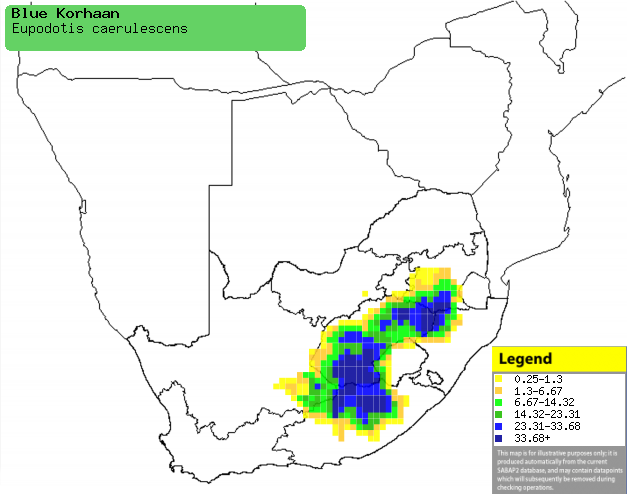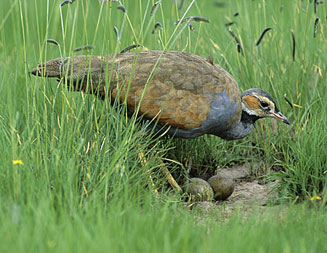|
Eupodotis caerulescens (Blue
korhaan)
Bloukorhaan [Afrikaans]; uMbukwane [Zulu]; Tlatlaoe [South
Sotho]; Blauwe trap [Dutch]; Outarde plombée [French]; Blautrappe [German];
Abetarda-azul [Portuguese]
Life
> Eukaryotes >
Opisthokonta
> Metazoa (animals) >
Bilateria >
Deuterostomia > Chordata >
Craniata > Vertebrata (vertebrates) > Gnathostomata (jawed
vertebrates) > Teleostomi (teleost fish) > Osteichthyes (bony fish) > Class:
Sarcopterygii (lobe-finned
fish) > Stegocephalia (terrestrial
vertebrates) > Tetrapoda
(four-legged vertebrates) > Reptiliomorpha > Amniota >
Reptilia (reptiles) >
Romeriida > Diapsida > Archosauromorpha > Archosauria >
Dinosauria
(dinosaurs) > Saurischia > Theropoda (bipedal predatory dinosaurs) >
Coelurosauria > Maniraptora > Aves
(birds) > Order: Gruiformes >
Family: Otitidae
Distribution and habitat
Endemic to southern Africa, occurring in the highveld of
South Africa surrounding and extending into Lesotho. It generally prefers flat
or undulating ground in grassland and Nama Karoo.
|
 |
|
Distribution of Blue korhaan in southern Africa,
based on statistical smoothing of the records from first SA Bird Atlas
Project (©
Animal Demography unit, University of
Cape Town; smoothing by Birgit Erni and Francesca Little). Colours range
from dark blue (most common) through to yellow (least common).
See here for the latest distribution
from the SABAP2. |
Call
Predators and parasites
Food
It mainly eats insects, lizards and plant matter, doing
most of its foraging by walking along and pecking the ground, often in
cultivated fields. The following food items have been recorded
in its diet:
- Animals
- invertebrates
- vertebrates
- Plants
- grass seeds
- flowers
- leaves of Themeda triandra (Red grass)
Breeding
- Its breeding system is complex, as it can be either monogamous or
polygamous, usually in trios with either two males or two females. However
it may also breed cooperatively in groups of up to five, together raising a
brood and defending the nest against predators.
- The nest is a simple scrape in the ground, usually between grass tufts
tall enough to conceal the incubating bird.
 |
|
|
Blue korhaan at its nest with eggs, Wakkerstroom,
South Africa. [photo
Warwick Tarboton ©] |
|
- Egg-laying season is from September-February, peaking from
October-November.
- It lays 1-2, rarely 3 eggs, which are solely incubated by a single
female or
multiple females (depending on the size of the family group) for about 24-28
days.
- The chicks are fed by both parents, leaving the nest soon after hatching
to join the family group, who vigorously defend them by chasing away or
distracting predators. The young take their first flight at about five weeks
old.
Threats
Near-threatened globally and regionally, although its
population is decreasing, probably due to habitat loss caused by cultivation,
human settlement and afforestation.
References
-
Hockey PAR, Dean WRJ and Ryan PG 2005. Roberts
- Birds of southern Africa, VIIth ed. The Trustees of the John Voelcker
Bird Book Fund, Cape Town.
|
